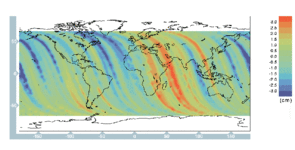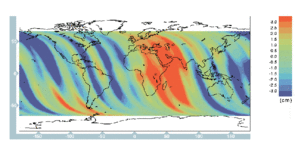Elfe : an orbit is born
F. Nouel (CNES, France)
The new T/P orbit produced by the DORIS Orbit Determination Group (DODG) at CNES for the Geophysical Data Records (GDRs) is called ELFE, a French acronym for estimation by empirical smoothing and filtering. Operational production of ELFE orbits starts with cycle 109. To maintain continuity in the quality of the orbits supplied to users, we recalculated the first 108 T/P cycles. They are acessible via PO.DAAC. Users will receive these with the updated and reprocessed GDR-M files.
What is an ELFE orbit?
It is a dynamic orbit calculated from DORIS and Laser measurements with JGM3 as the gravity model and the Grenoble hydrodynamic model (FES 95.2) for ocean tides. We then introduce stochastic forcing in the three directions (radial, along-track and perpendicular to the orbital plane) as a first-order Markov process. The forcing is estimated by least-squares analysis from DORIS and laser measurements. While DORIS does not match the GPS constellation in geometrical range, it offers the accuracy and coverage needed to apply the method. For GPS orbits, NASA/JPL’s reduced dynamic approach is based on Kalman filtering.
Why use both the CNES reduced and the NASA JGM3 dynamic orbit in the GDRs ?


Experience shows that the space-time error spectrum was comparable when CNES and NASA both produced dynamic orbits with JGM2. The change to JGM3 was deservedly successful with users, but two over-similar products would have added nothing. ELFE is a way of reshaping the error spectra while staying within a comparable accuracy range (2 to 3 cm).
After making sure the method used for the ELFE orbit does not produce spurious effects, i.e. checking that the estimated accelerations exhibit Markov behavior, conventional evaluation criteria such as laser rms or altimeter rms at crossover points show that the new ELFE orbits truly improve the DODG's dynamic orbit. The rms radial difference between the two ELFE orbits is always smaller than between the corresponding dynamic orbits. In other words, the ELFE stochastic process corrects the errors induced by the determinist part of the fit (due, for example to the gravity model used) in proportion to their amplitudes. This can even be so in areas the size of ocean basins. Relative to JGM2, JGM3 corrects some of the orbit errors geographically correlated in certain areas. This can be seen by comparing, point by point, dynamic orbits calculated with JGM2 and JGM3. The ELFE corrections to the JGM2 dynamic orbit are at roughly the same geographical positions, indicating that ELFE corrects actual geographically-correlated errors in the orbits calculated by JGM2.
How has ELFE helped?

Assuming ELFE orbits are closer to reality, the difference between ELFE and dynamic orbits reflects the gain from ELFE. By signal processing we can separate out the mean value over an orbital period, called a 'shift', from the deviation (or distortion) about this mean. The shift remains below 1 cm, but seems to be geographically correlated, with some stability from one cycle to the next. The distortion amplitude spectrum has spikes around the orbital frequency, some of which are more marked, at between 0.5 cm and 1 cm for spikes at 1/rev., 1/rev. ± 1/n days. We therefore believe these typical errors are smaller in the ELFE orbit. What remains is narrow-band normal white noise, with zero mean and standard deviation 0.5 cm or less.
Another external qualification test of the ELFE orbit is based on geodesy. The DODG calculates the mean position of all DORIS beacons over a month. The error becomes critical at such a level of accuracy, as the ELFE method relies essentially on the quality of DORIS measurements, and therefore on the beacon positions. Examining these solutions monthly (three T/P cycles) using both the dynamic orbit and the ELFE orbit shows that the ELFE results are: - more stable in terms of the terrestrial reference system, - compatible, in the case of many beacons, with the displacements of a few centimeters a year needed for geophysical modelling.
If you have any comments related to the ELFE orbit, the DODG would welcome them. Please contact Béatrice Barotto or Jean-Paul Berthias, who contributed to developing ELFE.
References
- Barotto B., J.P. Berthias, First results of Reduced Dynamics with DORIS on TOPEX/POSEIDON and SPOT. To appear in Journal of Guidance and Control (1994).
- Barotto B., Ph D Thesis, Paul Sabatier University, Toulouse (1995).




